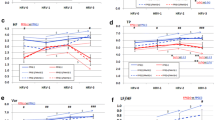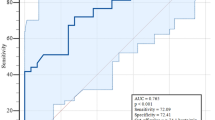Abstract
Background
Metabolic syndrome (MetS) prevalence shows some differences at various regions of the world in terms of race and ethnicity. The cardiac autonomic functions between Turkish and Japanese MetS patients with heart rate turbulence (HRT) and heart rate variability (HRV) were compared as the aim of this study.
Methods
This study consists of 149 nondiabetic subjects with MetS. All patients were further classified into subgroups based on ethnicity (76 from Turkey, 73 from Japan). Twenty-four-hour ambulatory Holter ECG recording was applied to all subjects whose HRV and HRT (total onset (TO), total slope (TS)) parameters were analyzed.
Results
The waist circumference was the only demographic parameter that was significantly different between the Turkish and Japanese patients with MetS (99.31 ± 6.12 vs 91.12 ± 6.89 for men and 91.48 ± 7.45 vs 86.26 ± 5.78 for woman; p < 0.001 and <0.001). There was a significant difference between Turkish and Japanese patients with MetS in terms of the HRT values. (TO Turkish, 0.77 ± 0.19 %; TO Japanese, 0.49 ± 1.03 %, p = 0.031; TS Turkish, 1.93 ± 1.26; TS Japanese, 2.44 ± 1.37, p = 0.041, respectively). As for HRV parameters, standard deviation of all NN intervals index was only different between Turkish and Japanese patients with MetS (90.79 ± 58.94, 128.18 ± 105.30; p = 0.034, respectively).
Conclusion
HRT and some HRV scores of ethnic Turkish MetS patients are worse than the scores of ethnic Japan MetS patients. We think that these differences are related to the central obesity.

Similar content being viewed by others
References
Task Force of the European Society of Cardiology and the North American Society of Pacing and Electrophysiology. (1996). Heart rate variability: standards of measurement, physiological interpretation and clinical use. Circulation, 93, 1043–1065.
Bauer, A., Malik, M., Schmidt, G., Barthel, P., Bonnemeier, H., Cygankiewicz, I., et al. (2008). Heart rate turbulence: standards of measurement, physiological interpretation, and clinical use: International Society for Holter and Noninvasive Electrophysiology Consensus. Journal of the American College of Cardiology, 52, 1353–1365.
Nikolopoulos, S., Alexandridi, A., Nikolakeas, S., & Manis, G. (2003). Experimental analysis of heart rate variability of long-recording electrocardiograms in normal subjects and patients with coronary artery disease and normal left ventricular function. Journal of Biomedical Informatics, 36(3), 202–217.
Wong, J. S., Lu, W. A., Wu, K. T., Liu, M., Chen, G. Y., & Kuo, C. D. (2012). A comparative study of pulse rate variability and heart rate variability in healthy subjects. Journal of Clinical Monitoring and Computing, 26(2), 107–114.
Watanabe, M. A. (2003). Heart rate turbulence: a review. Indian Pacing and Electrophysiology Journal, 3, 10–22.
Zarich, S. W. (2006). Metabolic syndrome, diabetes and cardiovascular events: current controversies and recommendations. Minerva Cardioangiologica, 54(2), 195–214. Review.
Mottillo, S., Filion, K. B., Genest, J., Joseph, L., Pilote, L., Poirier, P., et al. (2010). The metabolic syndrome and cardiovascular risk a systematic review and meta-analysis. Journal of the American College of Cardiology, 56, 1113–1132.
Alberti, K. G. M. M., Zimmet, P. Z., Shaw, J. E., & IDF Epidemiology Task Force Consensus Group. (2005). The metabolic syndrome: a new world-wide definition from the International Diabetes Federation consensus. Lancet, 366, 1059–1062.
Alberti, K. G., & Zimmet, P. Z. (1998). Definition, diagnosis and classification of diabetes mellitus and its complications. Part 1: diagnosis and classification of diabetes mellitus provisional report of a WHO consultation. Diabetic Medicine: A Journal of the British Diabetic Association, 15, 539–553.
Sengul, C., & Duman, D. (2011). The association of epicardial fat thickness with blunted heart rate recovery in patients with metabolic syndrome. The Tohoku Journal of Experimental Medicine, 224(4), 257–262.
Stein, P. K., Barzilay, J. I., Domitrovich, P. P., Chaves, P. M., Gottdiener, J. S., Heckbert, S. R., et al. (2007). The relationship of heart rate and heart rate variability to non-diabetic fasting glucose levels and the metabolic syndrome: the Cardiovascular Health Study. Diabetic Medicine: A Journal of the British Diabetic Association, 24, 855–863.
Anuurad, E., Chiem, A., Pearson, T. A., & Berglund, L. (2007). Metabolic syndrome components in African-Americans and European-American patients and its relation to coronary artery disease. The American Journal of Cardiology, 100, 830–834.
van Vliet, M., von Rosenstiel, I. A., Schindhelm, R. K., Brandjes, D. P., Beijnen, J. H., & Diamant, M. (2009). Ethnic differences in cardiometabolic risk profile in an overweight/obese paediatric cohort in the Netherlands: a cross-sectional study. Cardiovascular Diabetology, 8, 2.
Grassi, G., Dell’Oro, R., Facchini, A., Quarti Trevano, F., Bolla, G. B., & Mancia, G. (2004). Effect of central and peripheral body fat distribution on sympathetic and baroreflex function in obese normotensives. Journal of Hypertension, 22, 2363–2369.
Valsamakis, G., Chetty, R., Anwar, A., Banerjee, A. K., Barnett, A., & Kumar, S. (2004). Association of simple anthropometric measures of obesity with visceral fat and the metabolic syndrome in male Caucasian and Indo-Asian subjects. Diabetic Medicine, 21, 1339–1345.
Prineas, R. J., Folsom, A. R., & Kaye, S. A. (1993). Central adiposity and increased risk of coronary artery disease mortality in older women. Annals of Epidemiology, 3, 35–41.
Rogowski, O., Steinvil, A., Berliner, S., Cohen, M., Saar, N., Ben-Bassat, O. K., et al. (2009). Elevated resting heart rate is associated with the metabolic syndrome. Cardiovascular Diabetology, 8, 55.
Ó Hartaigh, B., Jiang, C. Q., Bosch, J. A., Zhang, W. S., Cheng, K. K., Lam, T. H., et al. (2012). Influence of heart rate at rest for predicting the metabolic syndrome in older Chinese adults. Acta Diabetologica. doi:10.1007/s00592-012-0396-z.
Rana, J. S., Hardison, R. M., Pop-Busui, R., Brooks, M. M., Jones, T. L., Nesto, R. W., et al. (2010). Resting heart rate and metabolic syndrome in patients with diabetes and coronary artery disease in bypass angioplasty revascularization investigation 2 diabetes (BARI 2D) trial. Preventive Cardiology, 13(3), 112–116.
Soucek, M. (2007). Can reduction in resting heart rate be beneficial for patients? Vnitrni Lekarstvi, 53(4), 401–403. Review.
Omar, A. R., Lee, L. C., Seow, S. C., Teo, S. G., & Poh, K. K. (2011). Managing ventricular ectopics: are ventricular ectopic beats just an annoyance? Singapore Medical Journal, 52(10), 707–713. quiz 714. Review.
Engel, G., Cho, S., Ghayoumi, A., Yamazaki, T., Chun, S., Fearon, W. F., et al. (2007). Prognostic significance of PVCs and resting heart rate. Annals of Noninvasive Electrocardiology, 12(2), 121–129.
Author information
Authors and Affiliations
Corresponding author
Rights and permissions
About this article
Cite this article
Erdem, A., Uenishi, M., Matsumoto, K. et al. Cardiac autonomic function in metabolic syndrome: a comparison of ethnic Turkish and Japanese patients. J Interv Card Electrophysiol 35, 253–258 (2012). https://doi.org/10.1007/s10840-012-9741-y
Received:
Accepted:
Published:
Issue Date:
DOI: https://doi.org/10.1007/s10840-012-9741-y




